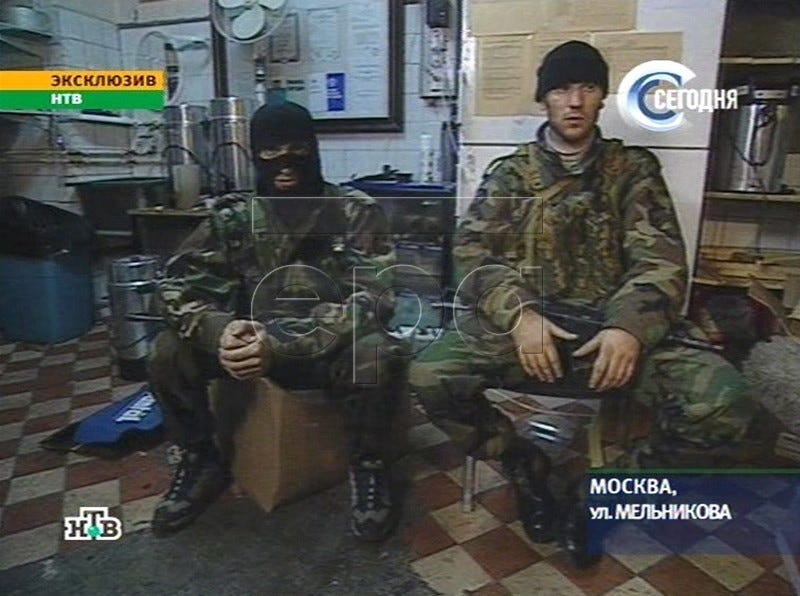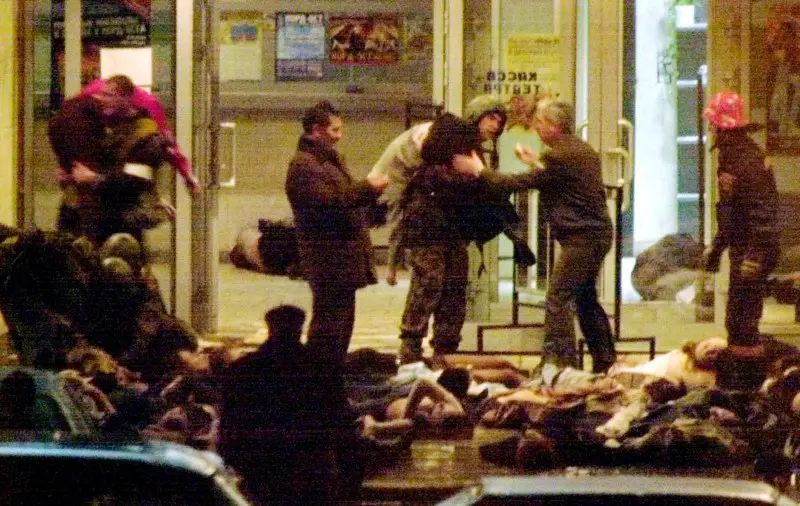 fter the fall of the Soviet Union, its former territories were thrown into conflict over the definition of their newfound borders. With many regions having their borders decided by the former USSR’s leadership, the newly independent countries sought to rectify these old decisions and decide their own fate. This meant war.
fter the fall of the Soviet Union, its former territories were thrown into conflict over the definition of their newfound borders. With many regions having their borders decided by the former USSR’s leadership, the newly independent countries sought to rectify these old decisions and decide their own fate. This meant war.
These wars raged on for years after the collapse, with one of the most significant being the Russian-Chechen wars. Major terrorist attacks would be performed by the Chechens during this conflict, but one would make the news headlines across the world. The 2002 Moscow Theatre Siege, also known as the 2002 Nord-Ost Siege.
Independence or Death
On 23 October 2002, the Dubrovka Theatre in Moscow was taken over by around 50 Chechen rebels. The theatre was full at the time due to the Nord-Ost play, a famous Russian play that led to the theatre being sold out. This resulted in 850 hostages being taken by the Chechen insurgents.

The attackers claimed allegiance to the Islamist separatist movement in Chechnya, a movement that strived for Chechnyan independence. The attackers’ demands for the Russian government were simple, the immediate and unconditional withdrawal of Russian troops from Chechnya. The government was given a one-week deadline to comply with the demands, after which the group would start killing their hostages.
The first day
After the initial takeover of the theatre, the terrorist would release a select amount of people whom they deemed as a nuisance for their operation. These people included foreigners who were visiting the theatre to see the play as well as some Russian children and women. In total, the number of people released on the first day ranges from 150 to 200.
A message was sent out to these hostages. Any intervention in the siege from special forces would result in heavy civilian casualties. The terrorist stated that for every insurgent killed, they would kill 10 of their hostages in return. This was a real threat as it was reported that the terrorists were armed with assault rifles, grenades, and homemade explosives. The Russian government could not treat this matter lightly.
The second day
Throughout the second day, negotiations continued through which another 39 hostages were released. Putin being president at the time, announced the current threat in Moscow and decided to cancel all of his plans. This included a meeting with President Bush which was put on hold in favor of Putin staying in the capital so he could consult his cabinet on how to solve the crisis.

After a talk with his cabinet, he decided to offer the terrorists free passage to another country if they left without harming the hostages. This message was quickly declined, with many of the released hostages relaying the same message as before. If the attackers’ requests were not taken seriously or if the government tried to intervene and free the hostages, there would be a bloodbath.
The day before the attack
The day before the attack of the Spetsnaz, the terrorist released a statement about their position after being offered freedom by the Russian president. In an interview with an NTV reporter (NTV is a Russian television channel), one of the attackers stated:
“We have nothing to lose. We have already covered 2,000 kilometres by coming here. There is no way back… We have come to die. Our motto is freedom and paradise. We already have freedom as we’ve come to Moscow. Now we want to be in paradise.”
Throughout this day, 4 Azerbaijani hostages and 23 Russian hostages were released, bringing the number of released hostages to around 200, although estimates vary due to the lack of concrete information from the Russian government.

On this day, it was also decided that the Спецназ ФСБ “Альфа” и “Вымпел” (Anglicised: Spetsnaz group “Alpha” and “Vympel”) should lead a raid on the terrorist during the early hours of the next day. This information was also released in a controlled leak which stated that the attack would take place at 3 a.m. the next day when the actual time the attack was meant to commence was 5 a.m.
26 October 2002
Before the attack could even begin, the special forces would run into a problem. The previous day’s information leak would backfire with two Alpha group members being injured by a hand grenade whilst maneuvering through the no-man zone around 3 a.m. After their extraction, the operation began at 5 a.m.

The most iconic and deadly part of this operation was the use of gas to pacify the terrorists inside. The gas was distributed through the vents of the theatre so it would reach every room. This chemical device was meant to knock out all of the attackers so that the building could be stormed with minimum casualties from both sides.
The only problem was that many of the terrorists were unaffected by the gas as they wore gas masks. Those most affected by this weapon were the civilians, as they did not have access to any form of respiratory device. This would prove fatal for many.
During the raid, the terrorists had no intention of shooting the remaining hostages telling them to lay down in the theatre seats so that they were out of the crossfire. The fierce fighting between the special forces and the defenders would last for approximately two hours, after which most of the defenders were left either dead, unconscious or in custody.
After the building was cleared, all of the hostages, of whom most were unconscious, were evacuated by the Spetsnaz, as seen in the thumbnail. Several buses and ambulances were lined up at the entrance of the theatre so that the hostages could be transferred to the relevant healthcare facilities.
The aftermath
The unforeseen consequences of using fentanyl-based gas would shock the nation. Out of the remaining hostages, around 200 were killed during the raid, with the biggest killer being the gas that was released by the special forces.
This would create a media catastrophe for both the Spetsnaz and the Russian president resulting in the damages of the operation being covered up as much as possible. To this day, exact data about the casualties from the raid can seldom be found.

Nothing was learned from this failure either, as only two years later, the Spetsnaz would face insurgents once more, this time leading to the death of 300, mostly children, during the Beslan school siege. The reputation of the Russian special forces would be stained forever.

Student of Philosophy, Politics and Economics. History fanatic. Contact: aneculaeseicg@gmail.com





